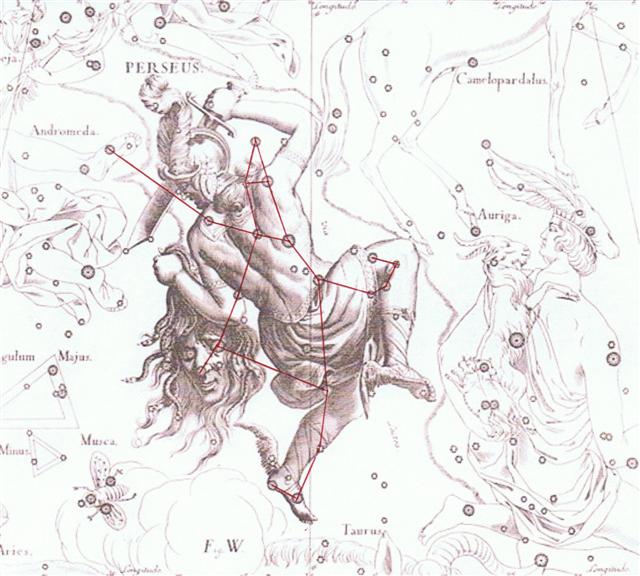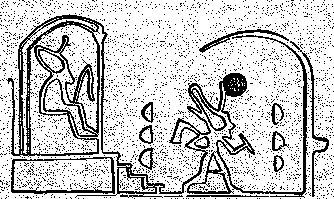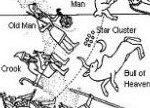Once again. In G the heliacal stars Sheratan and Aldebaran were probably indicated by a pair of vaha mea glyphs. The latter star was then contrasted with mago at heliacal Antares - making it clear that time was running uninterrupted past the end of side b and on to side a:
And the reader of the text could easily count 4 precessiona days back in time to find out what correlation there had been between the stars and the dates at the time of Gregory XIII:
But his main interest may have been the ancient time when Antares was with the Sun in SEPTEMBER 22 (*185) and heliacal Aldebaran at the ancient spring equinox in the north - at the time when the main star pictures could have been formed. For instance was Hamal the ancient leader after the Knot in Pisces (Alrisha): ... Brown associates it with Aloros, the first of the ten mythical kings of Akkad anterior to the Deluge, the duration of whose reigns proportionately coincided with the distances apart of the ten chief ecliptic stars beginning with Hamal, and he deduces from this kingly title the Assyrian Ailuv, and hence the Hebrew Ayil; the other stars corresponding to the other mythical kings being Alcyone, Aldebaran, Pollux, Regulus, Spica, Antares, Algenib, Deneb Algedi, and Scheat ... And 3 days earlier was the Scimitar:
... He also finds, from an inscription of the Tablet of the Thirty Stars, that the Euphratean astronomers had a constellation Gam, the Scimitar, stretching from Okda [another name for Alrisha, the knot] of the Fishes to Hamal of Aries, the curved blade being formed by the latter's three brightest components. This was the weapon protecting the kingdom against the Seven Evil Spirits, or Tempest Powers ... ... On came the monsters, came Pupa vae noa, and Poroporo tu a huanga, Toke a kura, and Tuna nui himself - they all came rushing on the land. And Tuna stripped off his loincloth, and he held it up; at once a mighty wave reared up and swept toward that land. Then Huahega shouted to her son, to Maui tikitiki, 'Quick now! Show them yours! Pull it out! ...
... he cut off Tuna's head to take it to his ancestor. But Huahega his mother took it from him and she said: 'You must bury this head of Tuna beside the post in the corner of our house.' Maui did so, and that head grew up, it sprouted, it became a coconut tree. On the nut which is its fruit we see the face of Tuna, eyes and mouth. All coconuts have this ... When reading the C text we can similarly pinpoint the stars from the appearance of honu glyphs where Spica (the leader of Virgo) was at the Full Moon and the Sun at the train of the garment of Andromeda - after the sky rafter stars (te heke) and 6 more had been counted in full (12 * 29 + 6 = 354):
When the Chorti diviners created a new foundation they probably thought where the stars had been anciently: ... On February 9 the Chorti Ah K'in, 'diviners', begin the agricultural year. Both the 260-day cycle and the solar year are used in setting dates for religious and agricultural ceremonies, especially when those rituals fall at the same time in both calendars. The ceremony begins when the diviners go to a sacred spring where they choose five stones with the proper shape and color. These stones will mark the five positions of the sacred cosmogram created by the ritual. When the stones are brought back to the ceremonial house, two diviners start the ritual by placing the stones on a table in a careful pattern that reproduces the schematic of the universe. At the same time, helpers under the table replace last year's diagram with the new one. They believe that by placing the cosmic diagram under the base of God at the center of the world they demonstrate that God dominates the universe. The priests place the stones in a very particular order. First the stone that corresponds to the sun in the eastern, sunrise position of summer solstice is set down; then the stone corresponding to the western, sunset position of the same solstice. This is followed by stones representing the western, sunset position of the winter solstice, then its eastern, sunrise position. Together these four stones form a square. They sit at the four corners of the square just as we saw in the Creation story from the Classic period and in the Popol Vuh. Finally, the center stone is placed to form the ancient five-point sign modern researchers called the quincunx ... The same should be the case when they began their sky raising ceremonies: ... Later on in this series of rituals, the Chorti go through a ceremony they call raising the sky. This ritual takes place at midnight on the twenty-fifth of April and continues each night until the rains arrive. In this ceremony two diviners and their wives sit on benches so that they occupy the corner positions of the cosmic square. They take their seats in the same order as the stones were placed, with the men on the eastern side and the women on the west. The ritual actions of sitting down and lifting upward are done with great precision and care, because they are directly related to the actions done by the gods at Creation. The people represent the gods of the four corners and the clouds that cover the earth. As they rise from their seats, they metaphorically lift the sky. If their lifting motion is uneven, the rains will be irregular and harmful ... |
||||||||||||||||||||||||||||||||||||||||||||||||||||||||||||||||||||||||||||||||||||||||||||||||||||||||||||||||||||||||||||||||||||||||||||||||||||||||||||||||||||||||||||||||||||||||||||||||||||||||||||||||||||||||||||||||||||||||||||||||||||||||||||||||||||||||||||||||||||||||||||||||||||||||||||||||||||||||||||||||||||||||||||||||||||||||
















